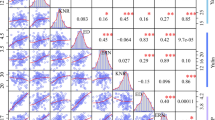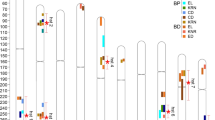Abstract
Ear traits are key contributors to grain yield in maize; therefore, exploring their genetic basis facilitates the improvement of grain yield. However, the underlying molecular mechanisms of ear traits remain obscure in both inbred lines and hybrids. Here, two association panels, respectively, comprising 203 inbred lines (IP) and 246 F1 hybrids (HP) were employed to identify candidate genes for six ear traits. The IP showed higher phenotypic variation and lower phenotypic mean than the HP for all traits, except ear tip-barrenness length. By conducting a genome-wide association study (GWAS) across multiple environments, 101 and 228 significant single-nucleotide polymorphisms (SNPs) associated with six ear traits were identified in the IP and HP, respectively. Of these significant SNPs identified in the HP, most showed complete–incomplete dominance and over-dominance effects for each ear trait. Combining a gene co-expression network with GWAS results, 186 and 440 candidate genes were predicted in the IP and HP, respectively, including known ear development genes ids1 and sid1. Of these, nine candidate genes were detected in both populations and expressed in maize ear and spikelet tissues. Furthermore, two key shared genes (GRMZM2G143330 and GRMZM2G171139) in both populations were found to be significantly associated with ear traits in the maize Goodman diversity panel with high-density variations. These findings advance our knowledge of the genetic architecture of ear traits between inbred lines and hybrids and provide a valuable resource for the genetic improvement of ear traits in maize.





Similar content being viewed by others
Data availability
All data is enclosed either in the main text or as supplementary data. Other data can be requested from the corresponding author.
References
Ayres DL, Darling A, Zwickl DJ et al (2012) BEAGLE: an application programming interface and high-performance computing library for statistical phylogenetics. Syst Biol 61(1):170–173
Bates D, Mächler M, Bolker B et al (2015) Fitting linear mixed-effects models using lme4. J Stat Softw 67:1–48
Bommert P, Lunde C, Nardmann J et al (2005) thick tassel dwarf1 encodes a putative maize ortholog of the Arabidopsis CLAVATA1 leucine-rich repeat receptor-like kinase. Development 132(6):1235–1245
Bortiri E, Chuck G, Vollbrecht E et al (2006) ramosa2 encodes a LATERAL ORGAN BOUNDARY domain protein that determines the fate of stem cells in branch meristems of maize. Plant Cell 18(3):574–585
Bradbury PJ, Zhang Z, Kroon DE et al (2007) TASSEL: software for association mapping of complex traits in diverse samples. Bioinformatics 23(19):2633–2635
Buckler ES, Holland JB, Bradbury PJ et al (2009) The genetic architecture of maize flowering time. Science 325(5941):714–718
Chuck G, Meeley R, Hake S (2008) Floral meristem initiation and meristem cell fate are regulated by the maize AP2 genes ids1 and sid1. Development 135(18):3013–3019
Chuck GS, Brown PJ, Meeley R et al (2014) Maize SBP-box transcription factors unbranched2 and unbranched3 affect yield traits by regulating the rate of lateral primordia initiation. Proc Natl Acad Sci USA 111(52):18775–18780
Danecek P, Auton A, Abecasis G et al (2011) The variant call format and VCFtools. Bioinformatics 27(15):2156–2158
Dong Z, Wang Y, Bao J et al (2023) The genetic structures and molecular mechanisms underlying ear traits in maize (Zea mays L.). Cells 12(14):1900
Duvick DN (2005) The contribution of breeding to yield advances in maize (Zea mays L.). Adv Agron 86:83–145
Eveland AL, Goldshmidt A, Pautler M et al (2014) Regulatory modules controlling maize inflorescence architecture. Genome Res 24(3):431–443
Galli M, Liu Q, Moss BL et al (2015) Auxin signaling modules regulate maize inflorescence architecture. Proc Natl Acad Sci USA 112(43):13372–13377
Guo M, Yang Y, Liu M et al (2014) Clustered spikelets 4, encoding a putative cytochrome P450 protein CYP724B1, is essential for rice panicle development. Chin Sci Bull 59(31):4050–4059
Gutiérrez L, Germán S, Pereyra S et al (2015) Multi-environment multi-QTL association mapping identifies disease resistance QTL in barley germplasm from Latin America. Theor Appl Genet 128(3):501–516
Huang X, Yang S, Gong J et al (2015) Genomic analysis of hybrid rice varieties reveals numerous superior alleles that contribute to heterosis. Nat Commun 6(1):6258
Hubert B, Rosegrant M, van Boekel MAJS et al (2010) The future of food: scenarios for 2050. Crop Sci 50(S1):S33–S50
Huo D, Ning Q, Shen X et al (2016) QTL mapping of kernel number-related traits and validation of one major QTL for ear length in maize. Plos One 11(5):e0155506
Je BI, Gruel J, Lee YK et al (2016) Signaling from maize organ primordia via FASCIATED EAR3 regulates stem cell proliferation and yield traits. Nat Genet 48(7):785–791
Jia H, Li M, Li W et al (2020) A serine/threonine protein kinase encoding gene KERNEL NUMBER PER ROW6 regulates maize grain yield. Nat Commun 11(1):988
Jiao Y, Peluso P, Shi J et al (2017) Improved maize reference genome with single-molecule technologies. Nature 546(7659):524–527
Kim D, Langmead B, Salzberg SL (2015) HISAT: a fast spliced aligner with low memory requirements. Nat Methods 12(4):357–360
Knapp SJ, Stroup WW, Ross WM (1985) Exact confidence intervals for heritability on a progeny mean basis. Crop Sci 25(1):192–194
Kraakman ATW, Niks RE, Van den Berg PMMM et al (2004) Linkage disequilibrium mapping of yield and yield stability in modern spring barley cultivars. Genetics 168(1):435–446
Langridge P, Lagudah ES, Holton TA et al (2001) Trends in genetic and genome analyses in wheat: a review. Aust J Agric Res 52(12):1043–1077
Li M, Guo X, Zhang M et al (2010) Mapping QTLs for grain yield and yield components under high and low phosphorus treatments in maize (Zea mays L.). Plant Sci 178(5):454–462
Li T, Dong Y, Zhang J et al (2022) Genome-wide association study of ear related traits in maize hybrids. Sci Agric Sin 55(13):2485–2499
Li T, Qu J, Tian X et al (2020) Identification of ear morphology genes in maize (Zea mays L.) using selective sweeps and association mapping. Front Genet 11:747
Li W, Yu Y, Wang L et al (2021) The genetic architecture of the dynamic changes in grain moisture in maize. Plant Biotechnol J 19(6):1195–1205
Li Z, Dong Y, Li T et al (2022) Genome-wide association analysis of yield and combining ability based on maize hybrid population. Sci Agric Sin 55(9):1695–1709
Li Z, Liu P, Zhang X et al (2020) Genome-wide association studies and QTL mapping uncover the genetic architecture of ear tip-barrenness in maize. Physiol Plant 170(1):27–39
Liu H, Wang Q, Chen M et al (2020) Genome-wide identification and analysis of heterotic loci in three maize hybrids. Plant Biotechnol J 18(1):185–194
Lu M, Xie C, Li X et al (2011) Mapping of quantitative trait loci for kernel row number in maize across seven environments. Mol Breed 28(2):143–152
Luo Y, Zhang M, Liu Y et al (2022) Genetic variation in YIGE1 contributes to ear length and grain yield in maize. New Phytol 234(2):513–526
Ma J, Cao Y (2021) Genetic dissection of grain yield of maize and yield-related traits through association mapping and genomic prediction. Front Plant Sci 12:690059
Pertea M, Kim D, Pertea GM et al (2016) Transcript-level expression analysis of RNA-seq experiments with HISAT, StringTie and Ballgown. Nat protoc 11(9):1650–1667
Purcell S, Neale B, Todd-Brown K et al (2007) PLINK: a tool set for whole-genome association and population-based linkage analyses. Am J Hum Genet 81(3):559–575
Qu J, Xu S, Gou X et al (2023) Time-resolved multiomics analysis of the genetic regulation of maize kernel moisture. Crop J 11(1):247–257
Quero G, Gutierrez L, Monteverde E et al (2018) Genome-wide association study using historical breeding populations discovers genomic regions involved in high-quality rice. Plant Genome 11(3):170076
Ren W, Zhao L, Liang J et al (2022) Genome-wide dissection of changes in maize root system architecture during modern breeding. Nat Plants 8(12):1408–1422
Satoh-Nagasawa N, Nagasawa N, Malcomber S et al (2006) A trehalose metabolic enzyme controls inflorescence architecture in maize. Nature 441(7090):227–230
Schaefer RJ, Michno J-M, Jeffers J et al (2018) Integrating coexpression networks with GWAS to prioritize causal genes in maize. Plant Cell 30(12):2922–2942
Vollbrecht E, Springer PS, Goh L et al (2005) Architecture of floral branch systems in maize and related grasses. Nature 436(7054):1119–1126
Wang B, Hou M, Shi J et al (2023) De novo genome assembly and analyses of 12 founder inbred lines provide insights into maize heterosis. Nat Genet 55(2):312–323
Wei T, Simko V, Levy M et al (2017) R package “corrplot.” Statistician 56:316–324
Wu T, Hu E, Xu S et al (2021) clusterProfiler 4.0: a universal enrichment tool for interpreting omics data. Innovation 2(3):100141
Xiao Y, Tong H, Yang X et al (2016) Genome-wide dissection of the maize ear genetic architecture using multiple populations. New Phytol 210(3):1095–1106
Yang L, Li T, Liu B et al (2021) Genetic analysis of ear-related traits under different pollination treatments in maize (Zea mays). Plant Breed 140(2):211–222
Zhang X, Ren Z, Luo B et al (2022) Genetic architecture of maize yield traits dissected by QTL mapping and GWAS in maize. Crop J 10(2):436–446
Zhao J, Guo J, Guo Q et al (1997) Correlation analysis of kernel number per ear and its components in different maize genotypes. Beijing Agric Sci 6:2–3
Zhou B, Zhou Z, Ding J et al (2018) Combining three mapping strategies to reveal quantitative trait loci and candidate genes for maize ear length. Plant Genome 11(3):170107
Zhou P, Hirsch CN, Briggs SP et al (2019) Dynamic patterns of gene expression additivity and regulatory variation throughout maize development. Mol Plant 12(3):410–425
Zhou X, Stephens M (2012) Genome-wide efficient mixed-model analysis for association studies. Nat Genet 44(7):821–824
Acknowledgements
We thank all members in the Key Laboratory of Biology and Genetic Improvement of Maize in Arid Area of Northwest Region for their help and support in field material planting and phenotype collection.
Funding
This work was supported by the Shanxi Province Research and Development Project (202102140601002) and Shaanxi Province Research and Development Project (2023-YBNY-027).
Author information
Authors and Affiliations
Contributions
JX and SX conceived and designed the experiments. XZ, YD, and ZF performed the experiments. HY, RL, NW, JZ, LZ, and XZ performed the experiments and collected and processed the data. TL analyzed the data, wrote the paper, and prepared figures and/or tables. All authors read and approved the final manuscript.
Corresponding authors
Ethics declarations
Ethics approval and consent to participate
Not applicable.
Consent for publication
The authors give consent for the publication.
Conflict of interest
The authors declare no competing interests.
Additional information
Publisher’s Note
Springer Nature remains neutral with regard to jurisdictional claims in published maps and institutional affiliations.
Rights and permissions
Springer Nature or its licensor (e.g. a society or other partner) holds exclusive rights to this article under a publishing agreement with the author(s) or other rightsholder(s); author self-archiving of the accepted manuscript version of this article is solely governed by the terms of such publishing agreement and applicable law.
About this article
Cite this article
Li, T., Yang, H., Zhang, X. et al. Genetic architecture of ear traits based on association mapping and co-expression networks in maize inbred lines and hybrids. Mol Breeding 43, 78 (2023). https://doi.org/10.1007/s11032-023-01426-9
Received:
Accepted:
Published:
DOI: https://doi.org/10.1007/s11032-023-01426-9




